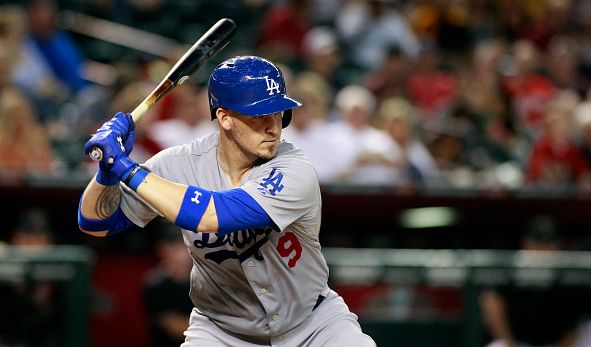Catchers and Relief Pitchers: Like Him Less, Like Him More

The article title tells the story. Below, you’ll find a catcher and relief pitcher I like less than the expert consensus rank at Fantasy Pros as well as one of each I like better. Interestingly, there are some parallels between the catchers — namely that both are coming off of putrid second halves in 2015 — and relievers — each induces ground balls at an exceptional rate.
Like Him Less
Stephen Vogt – ECR: C-10, My Rank: C-17
Stephen Vogt was a first-time all-star last year after a big first half (329 plate appearances, 14 homers, .211 ISO, .287 batting average, .374 OBP, .369 wOBA and 138 wRC+), but he fell off of a cliff in the second half (182 plate appearances, four homers, .133 ISO, .217 batting average, .280 OBP, .275 wOBA and 73 wRC+). The late-bloomer underwent arthroscopic surgery on his right elbow in January, but he’s in no danger of missing time early in the year and is already playing in spring training games. In fact, he’s not only playing, but he’s raking with six hits — including three homers — and two walks in 13 plate appearances. It’s possible his ECR could trend upward if other experts put any stock in the spring showing, but the red flags from his disastrous conclusion to last year warrant further investigation.
It’s usually unwise to parse a sample size too small, but Vogt’s 182 plate appearances in the second half account for 18.7% of his plate appearances in his big league career. With such a small sample size overall, it’s troubling that Vogt was terrible most recently. He suffered a power outage in the second half — as the ISO and home run totals above indicate — but also went backwards in walk rate and strikeout rate. His walk rate was slashed from 12.5% in the first half to 8.2% in the second half, and his strikeout rate crept up ever so slightly from 18.8% to 19.2%. Alone, the strikeout rate sneaking up a bit wouldn’t be problematic, but when coupled with a huge drop in walk rate, it’s not good.
His batted ball profile drastically changed between halves as well. In the first half, he ripped liners at a 23.2% rate with a 36.6% ground-ball rate, 45.5% pull rate and 29.5% hard-hit ball rate. Line drive rate takes a long time to stabilize, so take his rates by half with a grain of salt, but in the second half, he totaled a 19.7% line drive rate, 39.4% ground-ball rate, 38.6% pull rate and 22.7% hard-hit ball rate. By pulling the ball less frequently, he was unable to tap into his power. His lost line drives turned into ground balls, and he simply didn’t make as much hard contact. Is the book out on Vogt and has the league caught up to him? Perhaps. He plays his home games in a pitcher-friendly park and is lost against lefties, that much we know for sure. Add in the full assortment of bad second-half numbers, and Vogt shouldn’t be drafted as a starting catcher in standard single catcher leagues, yet the expert consensus suggests he should be.
Brad Ziegler – ECR: RP-24, My Rank: 30
Brad Ziegler isn’t a prototypical modern-day closer. He isn’t a flame thrower who racks up strikeouts. Instead, he relies on a gaudy ground-ball rate (72.8% in 2015) and the fielders behind him. Among pitchers who totaled a minimum of 60 innings pitched last year, Ziegler ranked second in ground-ball rate. Clearly he does an elite job of coaxing worm burners, but that’s all he does an elite job of.
The righty struck out only 13.7% of the batters he faced, and his walk rate (6.5%) was only a bit better than league average (7.7% in 2015, per FanGraphs). Batted ball luck greatly aided Ziegler last year as his .218 BABIP allowed crushed his career mark of .286 prior to last season. Regression to his normal rate of hits allowed on balls in play should push his WHIP above 1.20, and if his walk rate regresses closer to his career rate of 8.5%, a WHIP around 1.30 isn’t out of reach. Ziegler can already be counted on to be a non-contributor in strikeouts and a WHIP around 1.30 would make him a drag there, too.
The righty owns a career 2.47 ERA that smokes his ERA estimators (3.41 FIP, 3.52 xFIP and 2.81 SIERA), so it’s probably unfair to project him to his fielding independent pitching numbers, but he’s posted a lower strikeout rate than last year’s just once in his career (13.1% in 2008) and is banking on a volatile recipe for success.
The Diamondbacks have moved many of their chips to the middle of the table to make a run this year and over the next few seasons, and it’s hard to imagine Ziegler’s leash being long if a few batted balls burn him and result in blown saves. The club inked Tyler Clippard to a two-year contract, and the veteran reliever has 53 career saves (including 19 last year). Clippard’s previous closing experience makes him the most obvious threat to Ziegler’s claim on ninth-inning duties, but Daniel Hudson’s successful transition to the bullpen and electric stuff (97.09 mph average velo on his fourseam fastball in 2015, according to Brooks Baseball) makes him another candidate to usurp the job. Hudson ripped of a 13.0% swinging strike rate, and his changeup and slider give him the requisite goodies to shut down lefties and righties. Toss in Enrique Burgos as yet another big armed option (95.64 mph average velo on his fourseam fastball) who can miss bats (14.6% swinging strike rate and 32.2% strikeout rate in 30 appearances last season), and the Diamondbacks have plenty of alternatives should Ziegler falter. There are better cheap options for saves who aren’t totally reliant on the vagaries of batted balls for success.
Like Him More
Yasmani Grandal – ECR: C-12, My Rank: C-7
In his first season with the Dodgers, Yasmani Grandal smacked 16 homers with a .234 average and .353 OBP in 426 plate appearances. An uptick in walk rate and reduced strikeout rate helped him build on a decent 2014 in which he hit 15 homers with a .225 batting average and .327 OBP in 443 plate appearances. The full-season stats from last year don’t tell the whole story, though.
Grandal played through a shoulder injury that required surgery after the season, and his numbers spiraled down the toilet as a result. The surgery was an arthroscopic procedure to repair the A/C joint, but the labrum didn’t require any repair. The less substantial surgery is good news for his short-term outlook, and the switch-hitting catcher’s hot start to last year provides a glimpse of his upside.
In 257 plate appearances in the first half, Grandal belted 14 homers with a .282 batting average and .401 OBP. He walked in an astounding 16.3% of his plate appearances — making him especially useful in OBP leagues given the static nature of walk rates — while striking out in under 20% of his plate appearances. He was an above average offensive contributor against lefties (128 wRC+ in 2015) and righties (113 wRC+ in 2015), and he’s been an above average offensive option against both for his career (109 wRC+ against lefties and 120 wRC+ against righties). The Dodgers have a talented lineup that will probably force Grandal to hit down order, but their lineup depth should also provide him more run and RBI potential than your typical National League down order hitter. Grandal doesn’t even have to play at his 2015 first-half level in order to produce top-10 numbers at catcher, but the upside of doing so helped net him a top-10 rank from me.
Zach Britton – ECR: RP-9, My Rank: RP-4
The only pitcher who totaled a minimum of 60 innings pitched in 2015 with a higher ground-ball rate than Ziegler was none other than Zach Britton. The southpaw rattled off a 79.1% ground-ball rate last year, and he’s surpassed the 75% ground-ball rate threshold in consecutive seasons. He’s been a force since moving to the bullpen full time in 2014. Over the last two years combined, he owns a 77.0% ground-ball rate, and unlike Ziegler, he’s struck out a bunch of batters (26.4% strikeout rate in that time frame). Britton’s also done a good job of avoiding issuing free passes with a 6.9% walk rate since 2014. He’s tallied a sub-2.00 ERA in back-to-back seasons (1.65 in 2014 and 1.92 last year) and a sub-1.00 WHIP in each of those years (0.90 in 2014 and 0.99 last season). His ERA estimators over the last couple years are quite impressive, too, with a 2.61 FIP, 2.33 xFIP and 1.67 SIERA.
Despite the slight bump in ERA from 2014 to 2015, Britton made major strides in strikeout rate (21.8% in 2014 and 31.2% last year) and walk rate (8.1% in 2014 and 5.5% last year). The southpaw’s strikeout rate surge was supported by his swinging strike rate soaring from an already awesome 13.1% in 2014 to 16.4% last season. Britton has used his sinker more than 90% of the time the past two years, but unlike most sinkers, it’s a tough pitch to put wood on with a 13.73% whiff rate in 2014 and a 15.67% whiff rate in 2015, according to Brooks Baseball. The other pitch he turns to is his curveball, and he used it a little bit more last year bumping his usage rate up from 8.56% in 2014 to 9.62% last year. The curve went from a solid bat-misser (17.71% whiff rate in 2014) to a devastating put-away pitch (31.03% whiff rate in 2015). If Britton uses his curve a little more this year, it’s scary to consider his strikeout potential even with some regression to his whiff rate generated by the pitch last season. Britton’s an elite reliever whose expert consensus rank suggests he’s more good than great.


